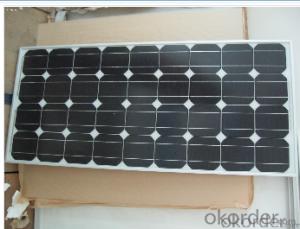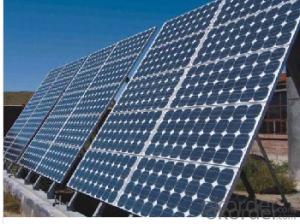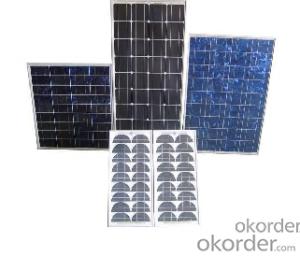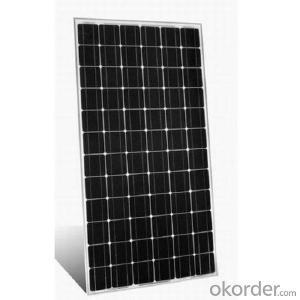Solar Module8 - Solar Panels Washington Township
- Loading Port:
- China Main Port
- Payment Terms:
- TT OR LC
- Min Order Qty:
- -
- Supply Capability:
- -
OKorder Service Pledge
OKorder Financial Service
You Might Also Like
Solar Module
ABOUT YINGLI GREEN ENERGY
Yingli Green Energy Holding Company Limited (NYSE: YGE) is one of
the world’s largest fully vertically integrated PV manufacturers, which
markets its products under the brand “Yingli Solar“. With over 7.0GW
of modules installed globally, we are a leading solar energy company
built upon proven product reliability and sustainable performance. We
are the fi rst renewable energy company and the fi rst Chinese company
to sponsor the FIFA World CupTM.
PERFORMANCE
- High effi ciency, multicrystalline silicon solar cells with high transmission
and textured glass deliver a module effi ciency of up to 16.0%,
minimizing installation costs and maximizing the kWh output of your
system per unit area.
- Tight positive power tolerance of 0W to +5W ensures you receive
modules at or above nameplate power and contributes to minimizing
module mismatch losses leading to improved system yield.
- Top ranking in the “TÜV Rheinland Energy Yield Test” and the
“PHOTON Test” demonstrates high performance and annual energy
production.
RELIABILITY
- Tests by independent laboratories prove that Yingli Solar modules:
Fully conform to certifi cation and regulatory standards.
Withstand wind loads of up to 2.4kPa and snow loads of up to
5.4kPa, confi rming mechanical stability.
Successfully endure ammonia and salt-mist exposure at the highest
severity level, ensuring their performance in adverse conditions.
- Manufacturing facility certifi ed by TÜV Rheinland to ISO 9001:2008,
ISO 14001:2004 and BS OHSAS 18001:2007.
WARRANTIES
- 10-year limited product warranty1.
- Limited power warranty1: 10 years at 91.2% of the minimal rated power
output, 25 years at 80.7% of the minimal rated power output.
1In compliance with our Warranty Terms and Conditions.
QUALIFICATIONS & CERTIFICATES
IEC 61215, IEC 61730, MCS, CE, ISO 9001:2008, ISO 14001:2004, BS OHSAS
18001:2007, PV Cycle, SA 8000
ELECTRICAL PERFORMANCE
Electrical parameters at Standard Test Conditions (STC)
Module type YLxxxP-29b (xxx=Pmax)
Power output Pmax W 260 255 250 245 240
Power output tolerances ΔPmax W 0 / + 5
Module effi ciency ηm % 16.0 15.7 15.4 15.1 14.8
Voltage at Pmax Vmpp V 30.3 30.0 29.8 29.6 29.3
Current at Pmax Impp A 8.59 8.49 8.39 8.28 8.18
Open-circuit voltage Voc V 37.7 37.7 37.6 37.5 37.5
Short-circuit current Isc A 9.09 9.01 8.92 8.83 8.75
Electrical parameters at Nominal Operating Cell Temperature (NOCT)
Power output Pmax W 189.7 186.0 182.4 178.7 175.1
Voltage at Pmax Vmpp V 27.6 27.4 27.2 27.0 26.8
Current at Pmax Impp A 6.87 6.79 6.71 6.62 6.54
Open-circuit voltage Voc V 34.8 34.8 34.7 34.6 34.6
Short-circuit current Isc A 7.35 7.28 7.21 7.14 7.07
STC: 1000W/m2 irradiance, 25°C cell temperature, AM1.5g spectrum according to EN 60904-3.
Average relative effi ciency reduction of 3.3% at 200W/m2 according to EN 60904-1.
NOCT: open-circuit module operation temperature at 800W/m2 irradiance, 20°C ambient temperature, 1m/s wind speed.
OPERATING CONDITIONS
Max. system voltage 1000VDC
Max. series fuse rating 15A
Limiting reverse current 15A
Operating temperature range -40°C to 85°C
Max. static load, front (e.g., snow) 5400Pa
Max. static load, back (e.g., wind) 2400Pa
Max. hailstone impact (diameter / velocity) 25mm / 23m/s
CONSTRUCTION MATERIALS
Front cover (material / thickness) low-iron tempered glass / 3.2mm
Cell (quantity / material / dimensions /
number of busbars)
60 / multicrystalline silicon / 156mm x 156mm / 2 or 3
Encapsulant (material) ethylene vinyl acetate (EVA)
Frame (material / color / anodization color /
edge sealing) anodized aluminum alloy / silver / clear / silicone or tape
Junction box (protection degree) ≥ IP65
Cable (length / cross-sectional area) 1000mm / 4mm2
Plug connector
(type / protection degree) MC4 / IP67 or YT08-1 / IP67 or Amphenol H4 / IP68
PACKAGING SPECIFICATIONS
Number of modules per pallet 29
Number of pallets per 40' container 28
Packaging box dimensions
(L / W / H) 1700mm / 1135mm / 1165mm
Box weight 568kg
Unit: mm
• Due to continuous innovation, research and product improvement, the specifi cations in this product information sheet are subject to change
without prior notice. The specifi cations may deviate slightly and are not guaranteed.
• The data do not refer to a single module and they are not part of the offer, they only serve for comparison to different module types
- Q: Can solar panels be installed on assisted living facilities?
- Yes, solar panels can be installed on assisted living facilities. In fact, many assisted living facilities are now opting for solar panel installations to reduce their energy costs and carbon footprint. Installing solar panels on these facilities not only helps save money in the long run but also promotes sustainability and environmental responsibility.
- Q: The Physics club in our school is trying to convince the Board of Ed to install solar panels in our school, and i was just wondering if anyone with some experience or real expertise in solar energy. I need some points about their usefulness some real pros and cons on maintenance, etc. Anything will help. Personally i would be perfectly for the idea, but i heard that the overall cost of installing them is much higher than the cost of the energy saved and government subsidies, but ive only heard about this.
- You have to approach it as an investment. Ignoring the cost of an inverter for net metering, if we consider a 500 W panel installed for $0 a watt which is $5,000 and consider an average of 8 hours of usable sunlight per day, and at a rate of $0.0 per kWh (schools probably get $0.03 per kWh) then the panel would be saving $2.7 per month in electricity. Considering that the panel has an expected lifespan of 20 years, that would give you an internal rate of return such that the monthly rate satisfies the equation: $5,000 = $2.7 * ( ( - / R^24 ) / ( - / R ) - ) By binary method we get R = 0.99588342. Taking this to the 2th power to annualize it we get Ra = 0.9570 which means that we are getting an annual return of -4.83% per annum so investing in the solar panel is the same as making an investment at an interest rate of -4.83% per year. True interest rates are low and you only get about .3% per annum by putting money in a CD but that still beats investing in solar panels which gives you a negative return on your money. Solar panels need to get a lot better before they are a good investment.
- Q: Can solar panels be used for powering a theme park or amusement park?
- Yes, solar panels can be used to power a theme park or amusement park. They can provide a sustainable and renewable source of energy to meet the power needs of various attractions, rides, and facilities within the park. By harnessing sunlight, solar panels can generate electricity that can be used directly or stored in batteries for later use. This not only reduces the park's carbon footprint but also helps to lower operational costs in the long run.
- Q: My family and I are looking into solar panels for our home. But I'm unsure how it would be priced. This month our home used ,623 kwh. The solar panel company said we should expect $6-$9 per watt used. What would that put as at?
- As the day progresses, solar panels start at near 0% efficiency, then to 00% at high noon, then drops off to 0% in the late afternoon. So you have to ask if the ,500 watt system is the peak output capacity or the AVERAGE output where the average would be near 70% or less of the peak over the day. Just do a LOT of research and number crunching. I'm waiting until it is cheap enough to by the whole system. A warranty is no good if the company goes out of business.
- Q: Can u guys help on how solar panels work and how it generates electricity?(or u can give me a good website that has solar panel info on it)~Thanks in advance!~
- Solar okorder under products that are sorted by watts per area. Also go to wikipedia to get more detailed information on solar cells.
- Q: can solar panels be on houses? malls?stores? WHAT ABOUT TRAINS?
- Solar panels are, well panels that take solar energy from the sun, and use it as heat or electricity. It is used for many things but depending on the power of the sun and the panel, they can be used for trains,houses to heat them but you need a lot of sun, and they don't work without sun obviously.
- Q: Main questions: How can I work out the efficiency of a solar panel and how can I work out if the panel is relatively cost-effective? Also what type of solar panels is considered most effiecient?Let's assume that all relative values are available.Secondary question: What type of safety regulations and licenses are required to be fulfiled in order to import solar panels into the EU from non-EU countries?
- The manufacturer of any serious panel should be able to provide an efficiency. That will be the STC power rating of the panel, divided by the area of the panel, divided by 000 w/m^2. But the more interesting figure is cost effectiveness, as you say, which is nothing more than cost per watt for the same class of panels. Most applications are limited by money, not by area.
- Q: Can solar panels work in cloudy weather?
- Yes, solar panels can still work in cloudy weather, although their energy production may be reduced. Cloud cover reduces the amount of sunlight reaching the panels, resulting in a lower output. However, modern solar panels are designed to generate electricity even in low-light conditions, making them still effective in producing energy during cloudy days.
- Q: How do solar panels perform in areas with high pollution levels?
- Solar panels are affected by high pollution levels as the presence of pollutants in the air can reduce their overall performance. The efficiency of solar panels decreases due to the reduced sunlight reaching the surface of the panels. Additionally, the accumulation of dust and particles on the surface of the panels can further hinder their performance by blocking sunlight. Regular cleaning and maintenance can help mitigate some of these effects, but high pollution levels can still have a negative impact on solar panel performance.
- Q: What sort of maintenance is required for solar panels....?
- New sunlight panels are easy and shiny they usually look cool. Then they get dirty with dirt and particles caught on the wind and residues left in the back of by rain and birds. Solar panels need to be by and large cleaned and maintained to be able to hold them running effectively and maximize the quantity of sunlight they convert into electricity. Unlike home windows your sun procedure wants to have a clean and clear surface to make sure they are working at their highest efficiency. If they are not at their surest performance it approach they are not producing the amount of electrical energy that they might be. Sun panels will attract filth, dirt, soot, pollen, tree sap and salt crystals in coastal areas creating a nice layer of dust. This sediment reduces the amount of light reaching the silicon cells underneath the glass floor and reduces the panel's effectiveness. A solar panel that has on no account been cleaned would be producing almost a 3rd less power than it or else could be. Some have mentioned a ten to fifteen percentage lack of sun output as a result of dirty panels. From the ground the panels may just appear to be clean, similar to your windows. Up close nevertheless you will see the grime that has built up from the grime and pollution within the air. A extra visible deposit that can be left on panels is fowl droppings. These tend to wholly block the sunshine from areas of the photovoltaic panel and may colossal scale back its effectiveness. See much more about sun panels preservation beneath link
Send your message to us
Solar Module8 - Solar Panels Washington Township
- Loading Port:
- China Main Port
- Payment Terms:
- TT OR LC
- Min Order Qty:
- -
- Supply Capability:
- -
OKorder Service Pledge
OKorder Financial Service
Similar products
Hot products
Hot Searches
Related keywords



















